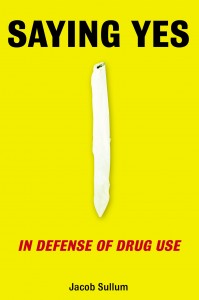Review: Saying Yes

“Humans have brains that are built to work on anecdote rather than real data.” [Jeffrey P. Utz, MD]
Man’s relationship with drugs has been one long and turbulent ride. Since first contact they’ve been consumed, smoked, inhaled and injected for everything from their mood-altering effects to their analgesic properties. Across generations and cultures, the legal status of nicotine, ethanol (the ingredient that supplies alcohol its intoxicating highs), cannabis and a congeries of other psychoactive substances has oscillated from complete prohibition to medicinal use only to nonmedicinal recreational, with some blurry shades in between.
In the United States, the posture on narcotics is one of quick suspicion and reproach, tilting lopsidedly toward criminalization. Columnist Jacob Sullum explores this general attitude in Saying Yes: In Defense of Drug Use with a data-centric focus, asking whether existing drug policies and popular perception are sensible or whether the conversation has been hijacked by false prophets and disinformation.
After canvassing the world religions for their perspectives on various euphoriants, Sullum transitions to the pith of his ensuing narrative: the statistics on drug usage. Any attempt to dissect the war on drugs must at minimum involve a familiarity with the hard data on psychotropic substances both licit and illicit. Sullum provides this in spades, chronicling usage statistics and dozens of studies on marijuana, methamphetamine, LSD, MDMA (ecstasy), PCP, cocaine, crack cocaine and heroin.
Anti-drug activists rely primarily on a two-pronged prosecution: 1) an inordinate amount of crime is caused by drug use and 2) moderation is impossible or something like impossible. But are these persevering assumptions tenable? What does the research show?
The literature simply does not support these claims, no matter how loudly certain media and abstinence hounds continue to repeat them. Above all, Saying Yes takes aim at the myth of “voodoo pharmacology,” which Sullum defines as the notion “that drugs control people rather than the other way around” (p. 268). The idea that drugs in some tangible or abstract sense recircuit the brain and neutralize free will is certainly a valuable defense for a user who stands convicted of a crime, but it reflects a misimpression of the particulars of substance dependence (the medically preferred term to ‘addiction’) as well as a failure to zoom out and examine precursor effects.
“…the conventional understanding of addiction, which portrays it as a kind of chemical slavery in which the user’s values and wishes do not matter, is fundamentally misleading.” (p. 27)
What the data indicate is that actions and conduct while under the influence of narcotics, and the level of substance dependence achieved, have more to do with the user’s preexisting psyche and his or her sociocultural circumstances than anything inherent to the drug itself. Someone down on their luck not only may be more likely to use in the first place, but their personality, ongoing situation and expectations of taking the drug tend to steer the attendant psychoactive effects in consistent, if not altogether predictable directions.
“…it’s clear that happy, well-adjusted people are less likely to get into trouble with drugs.” (p. 280)
When we take a look at crimes alleged to be the result of drug use, we consistently find that the perpetrator had a history of crime, violence and/or antisocial tendencies. Rarely do we find a pattern of nonviolence abruptly interrupted by a drug-fueled spree of immoderate behavior and crime. If any one drug had a direct tendency to warp human behavior in ways that enact unprecedented transformations on the part of the user, then we should expect to find a distribution of users with dissimilar backgrounds exhibiting similar behavior while under the influence of said drug.
We do not find this: drug-associated crimes and the extent to which they are abused tend to draw more from proximate circumstances like one’s social environment and lifestyle. Thus contrary to the spurious connections found in mainstream rhetoric, recreational drugs do not regularly turn docile, reticent individuals into unfeeling, reckless, sex-crazed brutes, or vice versa.
The Golden Mean
On the second point almost universal to drug prohibitionist rhetoric, the copious data indicate that most narcotics users — the statistics are more or less consistent for all drugs surveyed — do so in moderation and lead functional, productive lives. Questions over how to define ‘moderation’ can be disambiguated by looking to alcohol as a proxy. All of us either know people who consume alcohol more than occasionally or do so ourselves without manifesting life-destructive patterns. Just as most are not burdened by their forays with alcohol, the data-driven profile of the typical narcotics user is someone who indulges their desire for certain substances while being fully moored as a functioning unit of society.
“The portrait of predictable escalation from experimentation to an unbreakable habit was wrong when it was applied to drinking, and it is no less mistaken as a description of illegal drug use-even such reputedly powerful substances as heroin, crack, and methamphetamine-do not typically become addicts.” (p. 27)
To understand why moderation is the rule and not the rarefied exception requires nothing like the bad-faith moral authority deployed by anti-drug lobbyists. It merely requires we approach the question in terms of benefits and risks. Often enough, one’s desire to return to the drug is overridden by one’s commitments to family, friends and other social and occupational obligations. Conversely, those with low economic security and no social safety net are more likely to develop drug dependency issues.
Much like alcoholism, without a resume of responsibility to attend to and other societal pressures in place to curb excess, it becomes decidedly easier to fall prey to overuse. Yet for the vast majority of more than one-time users, their drug of choice yields temporary highs, in between which they are free to pursue the activities that fill up the remainder of their day without negative interference. While the war on drugs tends to dichotomize usage in terms of extremes, there is clearly ample space between abstention and enslavement.
Deconstructing the Dysmorphia
Given the limpidity of the data on narcotics usage, what can explain the abiding cultural stigma? A lot of it, Sullum recommends, is grounded in misjudgments by people who have never used the drug in question or recreational drugs in general, who jump to hasty conclusions based on superficial connections. ‘Since Tom is a junkie and has done nothing with his life, drugs must be to blame’, or ‘I see what drugs have done to this person and I don’t want it to happen to me.’
But it is the media that have reinforced these latent preconceptions by playing up anecdotes and downplaying the (admittedly less captivating) empirical side of the equation. Sullum lays special emphasis on alcohol throughout, one of humanity’s eldest drugs, refusing to keep it far from overheard while assessing the risk of currently targeted illicit substances. After all, alcohol went through its own prohibition period and over the decades precisely the same arguments leveled at alcohol to keep it off the shelves have been redirected at the menace of the week.
Indeed, the statistics on crime and violence can be easily torqued to incriminate alcohol, too. Just as the media played central roles both in the declamation and legalization of alcohol, so it plays equivalently critical roles in the domain of nonalcoholic substances. As more of the silent majority opens up about their drug habits, the quicker entrenched stereotypes will dissolve.
Another key to changing public perception is attention from the medical establishment. There are a number of accepted therapeutic treatments that overlap significantly with narcotics in terms of the ailments they target as well as their pharmacological effects. In many cases the disorders certain popularly prescribed drugs purport to treat are only hazily distinguished from reasons users turn to illicit substances with similar pharmacological profiles. Ecstasy, for example, is often taken to improve one’s experience in social settings, and there is no evidence that MDMA involves higher substance dependence issues than commonly prescribed remedies.
“Taking MDMA to overcome shyness is drug abuse, but prescribing Paxil to treat “social anxiety disorder” is good medicine. Legally, the distinction between medical and nonmedical is clear. Conceptually, it has never been blurrier.” (pp. 252-253)
Marijuana, once characterized as a gateway drug on the road to ruin is of course well on its way to mass legalization. Its medicinal value as an antiemetic and antispasmodic and its subtle analgesic effects have led to relaxed legal controls in the US. As of this writing, marijuana possession and sale is legal in twenty states and the District of Columbia.
The Exacerbations of Embargo
Toward the close of the book, Sullum spends some time analyzing how usage patterns might shift following a removal of the drug ban. For one, any time a product is sequestered to the black market, the opportunities for violence multiply. A move toward decriminalization would reduce crime associated with sales, acquisition and distribution. Second, unregulated markets translate to heavily inflated prices. Heroin, for example, can cost forty to fifty times more than a legal dose, making illicitly obtained substances more likely to drive users into economic instability and social and physical degeneration.
Third, absent regulation a whole miscellany of hazards comes into play including dummy doses, poisoned doses and overdoses. Fourth, due to the high costs, heroin and other opiate habitués are more likely to inject the drug — a more guaranteed and efficient method of uptake — raising the potential for transmission of diseases through shared injection materials.
In a post-criminalized world, the aforementioned social safeguards that promote healthy usage patterns would remain intact, thereby reducing the overall number of poor outcomes. And on a more philosophical level, the repeal of our regulatory apparatus would force us to come to grips with the dark side of human nature that feeds into the pernicious behavior for which drugs have often been substituted as a scapegoat.1
Closing Thoughts
Clocking in at just 284 pages, Saying Yes isn’t the lengthiest book on the topic, but Sullum manages to cram a Titanic’s worth of useful information into its slender form. It is a balanced, data-sensitive look at an uneasy and highly controversial topic. In navigating the divide between use and abuse, Sullum forthrightly avoids the monochrome portrayals of drug users prevalent in media caricatures in favor of thorough, wide-angle analysis. Many of my own preconceptions were challenged and tossed aside. Read the hard statistics on “hard” drugs and decide for yourself whether the criminalization paradigm is worthwhile, whether it creates more harm than good, and whether psychoactive effects reflect more the properties of the drug or the individual.
As I progressed and read about how (and how quickly!) public perception has changed with respect to certain drugs, how stereotypes and stigmas have rotated among different drugs at different times, in some cases even different classes of drugs, and how media and social cues completely parameterized the debate and national discourse, the more I recalled the quote preceding this review. We are wooed by anecdotes and tranquilized by data. Efforts like Saying Yes have the potential to reverse this asymmetry.
Perhaps the only knock against the book I could muster is Sullum’s early fixation on religion’s history with forbidden substances, which read like an extended preamble and seemed somewhat removed from the regime of relevance to the war on drugs. Quibbles aside, Saying Yes should be requisite reading for an informed discussion on the longstanding war on drugs, for relating to friends, family and relatives who may be recreationally friendly with narcotics, and for anyone considering incorporating them into their own regimen.
Note: This review is mirrored over at Goodreads and at Amazon.
Feature image credit: REUTERS/Daniel LeClair
- Also see: video games. [↩]



Comments